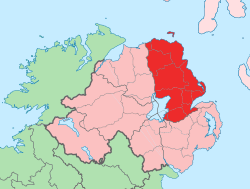County Antrim
|
County Antrim Contae Aontroma
Coontie Antrìm/Countie Antrim |
||
|---|---|---|
|
||
| Motto: Per angusta ad augusta (Latin) "Through Trial to Triumphs" |
||
 |
||
| Country | Northern Ireland | |
| Region | Antrim | |
| Province | Ulster | |
| County town | Antrim | |
| Area | ||
| • Total | 3,046 km2 (1,176 sq mi) | |
| Area rank | 9th | |
| Population (est. 2011) | 618,108 | |
| • Rank | 2nd | |
| Contae Aontroma is the Irish name; Coontie Antrìm,Countie Antrim,Coontie Anthrim and Coonty Entrim are Ulster-Scots names. | ||
County Antrim (named after the town of Antrim) is one of six counties that form Northern Ireland, situated in the north-east of the island of Ireland. Adjoined to the north-east shore of Lough Neagh, the county covers an area of 3,046 square kilometres (1,176 sq mi) and has a population of about 618,000. It is one of six traditional counties of Northern Ireland and is within the historic province of Ulster. County Antrim has a population density of 203 people per square kilometer / 526 people per square mile.
The Glens of Antrim offer isolated rugged landscapes, the Giant's Causeway is a unique landscape and a UNESCO World Heritage Site, Bushmills produces whiskey, and Portrush is a popular seaside resort and night-life area. The majority of Belfast, the capital city of Northern Ireland, is in County Antrim, with the remainder being in County Down.
It is currently one of only two counties of Ireland to have a majority of the population from a Protestant background, according to the 2001 census. The other is County Down to the south.
A large portion of Antrim is hilly, especially in the east, where the highest elevations are attained. The range runs north and south, and, following this direction, the highest points are Knocklayd 514 m (1,690 ft), Slieveanorra 508 m (1,670 ft), Trostan 550 m (1,800 ft), Slemish 437 m (1,430 ft), Agnew's Hill 474 m (1,560 ft) and Divis 478 m (1,570 ft). The inland slope is gradual, but on the northern shore the range terminates in abrupt and almost perpendicular declivities, and here, consequently, some of the finest coast scenery in the world is found, widely differing, with its unbroken lines of cliffs, from the indented coast-line of the west. The most remarkable cliffs are those formed of perpendicular basaltic columns, extending for many miles, and most strikingly displayed in Fair Head and the celebrated Giant's Causeway. From the eastern coast the hills rise instantly but less abruptly, and the indentations are wider and deeper. On both coasts there are several resort towns, including Portrush (with well-known golf links), Portballintrae and Ballycastle; on the east Cushendun, Cushendall and Waterfoot on Red Bay, Carnlough and Glenarm, Larne on the Sea of Moyle, and Whitehead on Belfast Lough. All are somewhat exposed to the easterly winds prevalent in spring. The only island of size is the L-shaped Rathlin Island, off Ballycastle, 11 km (6.8 mi) in total length by 2 km (1.2 mi) maximum breadth, 7 km (4.3 mi) from the coast, and of similar basaltic and limestone formation to that of the mainland. It is partially arable, and supports a small population. Islandmagee is a peninsula separating Larne Lough from the North Channel.
...
Wikipedia

